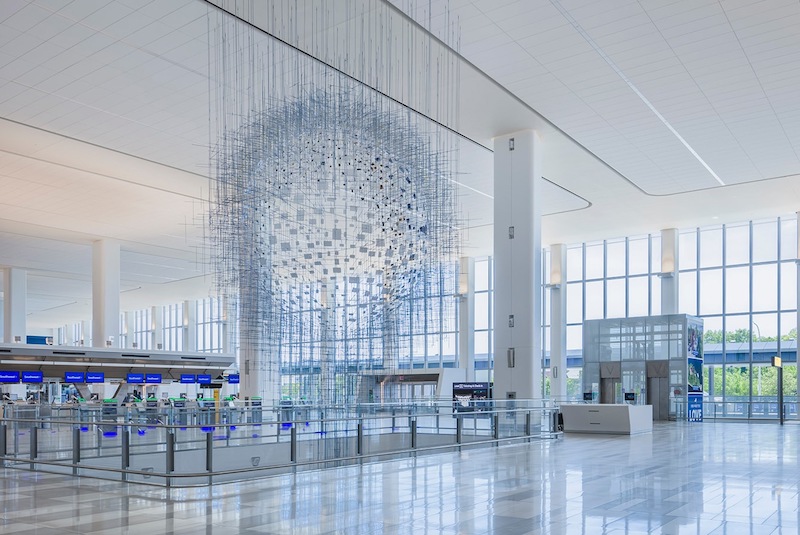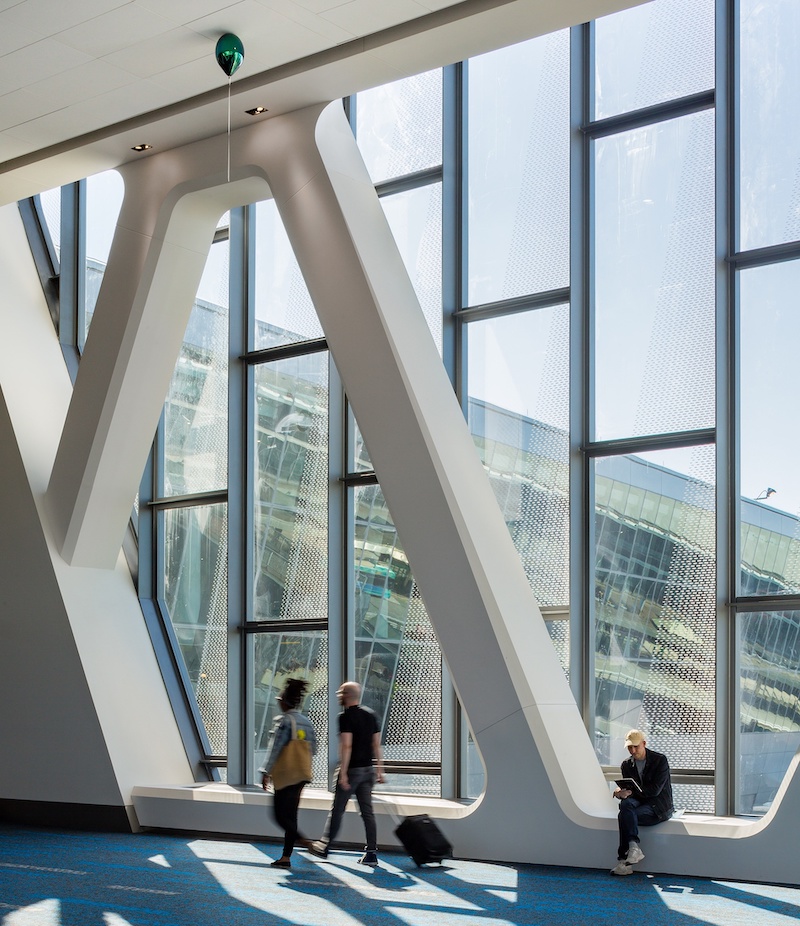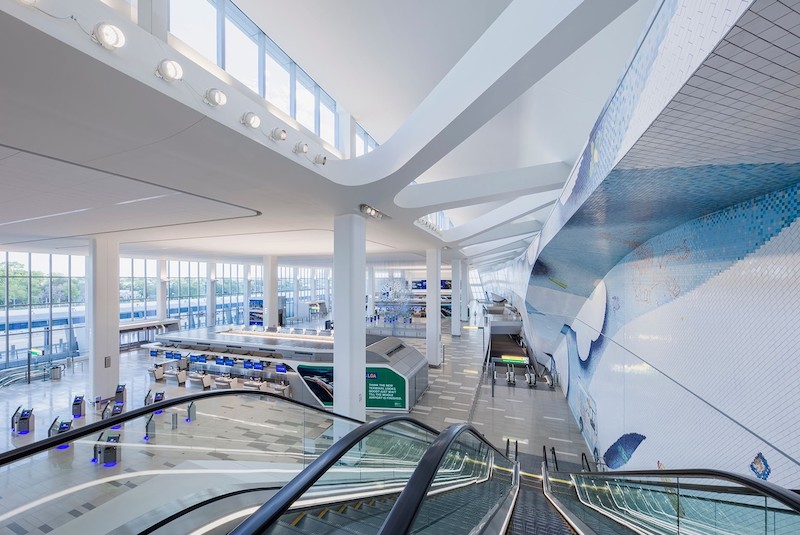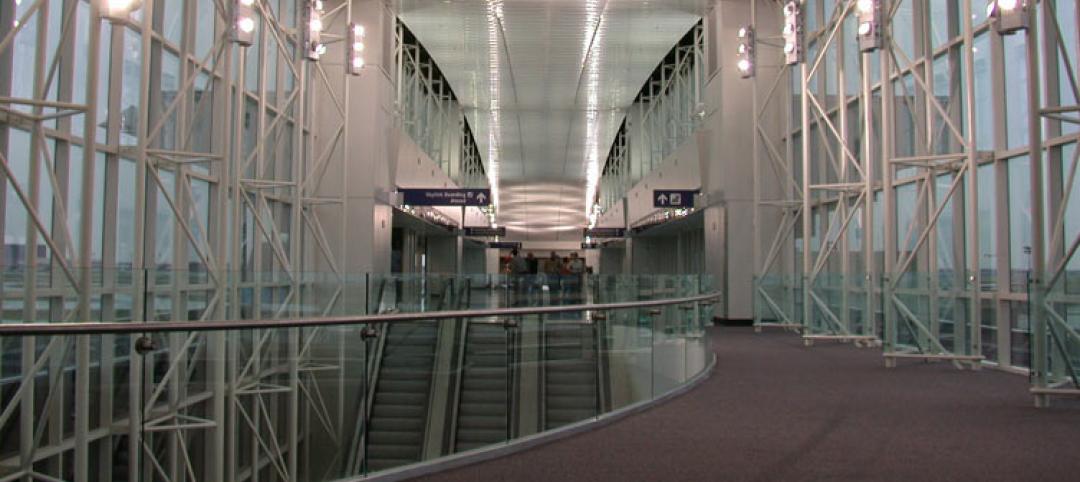LaGuardia Airport’s new Terminal B, a four-story, 850,000-sf facility that houses passenger services and amenities, has officially opened.
The steel-framed facility replaces a disjointed patchwork of structures with one that closely follows the curves of the Grand Central Parkway and the airport access roads. It was designed as a highly efficient and adaptable terminal that pays homage to the “architectural grandeur and individuality” of New York City.
“Our design concept focuses on two main components: a superior passenger experience and an exterior architectural expression that conveys a civic presence from the Grand Central Parkway,” said Carl Galioto, FAIA, HOK’s President and New York Office Managing Principal. “The building is a metaphor for New York, a city of islands and bridges, and the terminal is connected to the city with views of the skyline from the passenger bridges. Our ambition was to help transform LaGuardia into an airport with a distinct civic identity worthy of this metropolis.”

Also known as a headhouse, Terminal B includes extensive food and beverage and retail options. Connected to two island concourses by a pair of 450-foot-long steel truss pedestrian bridges, the headhouse serves as the nexus to the new Terminal B. Arriving and departing passengers can view panoramic skyline and airfield views from the transparent-walled, 65-foot-high bridges as taxiing planes pass underneath them. The bridges also enabled the design team to move the terminal 600 feet closer to the Grand Central Parkway, which allowed for two additional miles of aircraft taxi lanes that will reduce airport ground delays.
The team designed a simplified circulation network comprising over eight miles of new roadway and 20 new bridges that provide an easy connection from the airport to the Grand Central Parkway and New York City. The roadways in front of the head house frame the Grand Central Parkway, and its column structures align with the head house design to create a cohesive appearance.

Inside the terminal, all check-in and passenger screening areas are located on the third floor. This location gives Terminal B the adaptability to accommodate evolving security screening and technology as needs change. The “common-use” design allows airlines to move easily within the terminal, expanding or shrinking their footprints as needed.
See Also: A 780-ft-long pedestrian walkway is positioned over an active taxi lane at Sea-Tac International
Terminal B forgoes the widespread practice among airports of offering monumental spaces to departures while relegating low-ceilinged, basement-like zones to arrivals; incoming and outgoing passengers to Terminal B share soaring, grand-scaled sequences.

Sustainability features include non-glare daylighting, passive shading, natural local materials, and storm resiliency and the new infrastructure layout will reduce the airport’s overall carbon footprint due to lower fuel demands from taxiing aircraft. The project is targeting LEED Silver certification.
LaGuardia Gateway Partners is composed of Vantage Airport Group, Skanska, Meridiam and JLC Infrastructure for development and equity investment. Vantage Airport Group leads the redevelopment program and management of Terminal B, with Skanska Walsh as the design-build joint venture and HOK and WSP for design.

Related Stories
| Aug 22, 2013
Energy-efficient glazing technology [AIA Course]
This course discuses the latest technological advances in glazing, which make possible ever more efficient enclosures with ever greater glazed area.
| Aug 21, 2013
Why research is the ticket to successful airport wayfinding
Wayfinding is more than just signs; it requires a holistic approach based on communicating information that helps people make the right decision at the right time.
| Aug 19, 2013
Discovery of hidden asbestos complicates DFW terminal renovations
The finding of more asbestos in Terminal B than expected, and the pending merger of US Airways and the airport’s largest tenant, American Airlines, is causing construction delays on a $2.3 billion Dallas/Fort Worth Airport terminal renovation.
| Aug 19, 2013
Integration of solar panels in building skin seen as key net-zero element
Recent high-profile projects, including stadiums in Brazil for the upcoming World Cup and Summer Olympics and a bank headquarters in the U.K., reflect an effort by designers to adopt building-integrated photovoltaics, or BIPV.
| Aug 14, 2013
Green Building Report [2013 Giants 300 Report]
Building Design+Construction's rankings of the nation's largest green design and construction firms.
| Jul 29, 2013
2013 Giants 300 Report
The editors of Building Design+Construction magazine present the findings of the annual Giants 300 Report, which ranks the leading firms in the AEC industry.
| Jul 22, 2013
Transportation Facility Report [2013 Giants 300 Report]
Building Design+Construction's rankings of design and construction firms with the most revenue from airport terminals and other transportation-related facilities, as reported in the 2013 Giants 300 Report.
| Jul 19, 2013
Renovation, adaptive reuse stay strong, providing fertile ground for growth [2013 Giants 300 Report]
Increasingly, owners recognize that existing buildings represent a considerable resource in embodied energy, which can often be leveraged for lower front-end costs and a faster turnaround than new construction.
| Jul 18, 2013
Top Local Government Sector Construction Firms [2013 Giants 300 Report]
Turner, Clark Group, PCL top Building Design+Construction's 2013 ranking of the largest local government sector contractor and construction management firms in the U.S.
| Jul 18, 2013
Top Local Government Sector Engineering Firms [2013 Giants 300 Report]
STV, URS, AECOM top Building Design+Construction's 2013 ranking of the largest local government sector engineering and engineering/architecture firms in the U.S.














